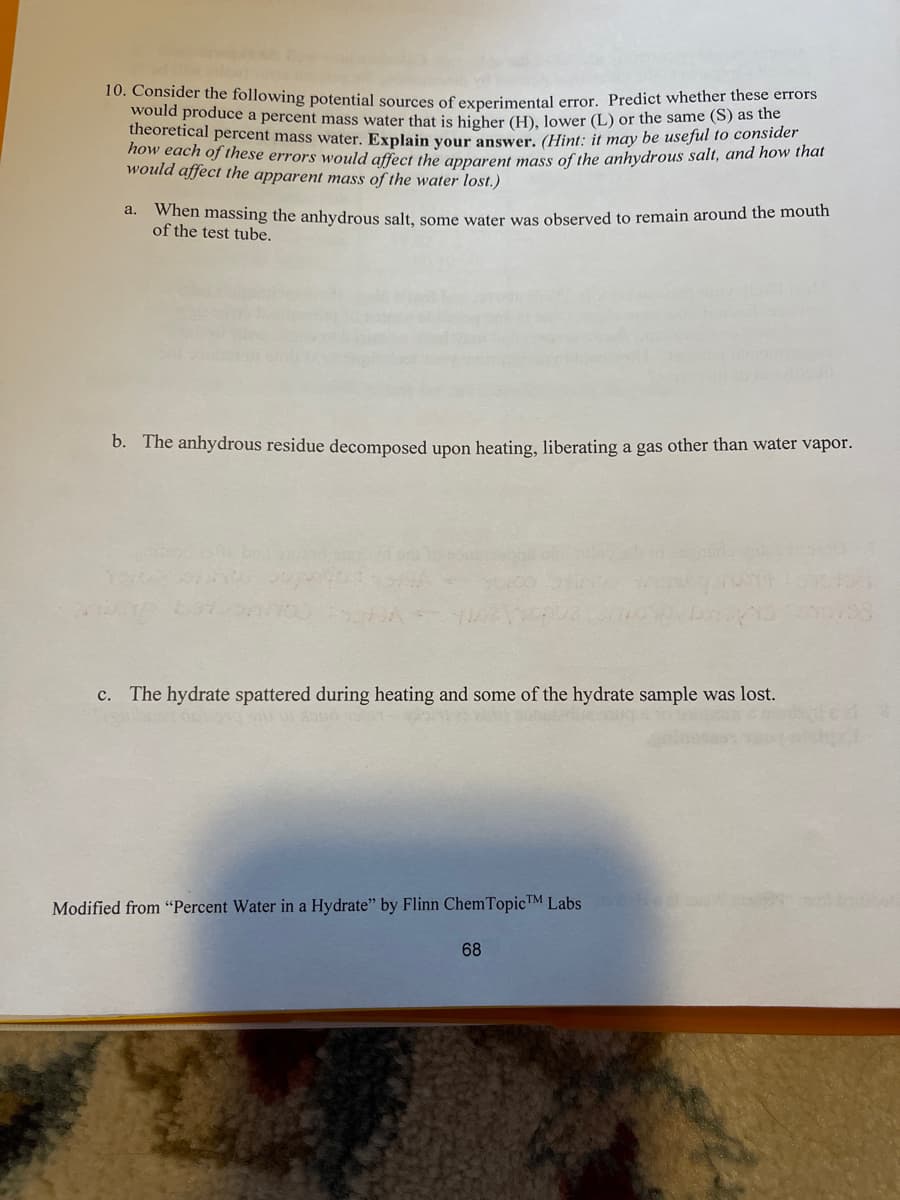10. Consider the following potential sources of experimental error. Predict whether these errors would produce a percent mass water that is higher (H), lower (L) or the same (S) as the theoretical percent mass water. Explain your answer. (Hint: it may be useful to consider how each of these errors would affect the apparent mass of the anhydrous salt, and how that would affect the apparent mass of the water lost.) a. When massing the anhydrous salt, some water was observed to remain around the mouth of the test tube. b. The anhydrous residue decomposed upon heating, liberating a gas other than water vapor. c. The hydrate spattered during heating and some of the hydrate sample was lost.
10. Consider the following potential sources of experimental error. Predict whether these errors would produce a percent mass water that is higher (H), lower (L) or the same (S) as the theoretical percent mass water. Explain your answer. (Hint: it may be useful to consider how each of these errors would affect the apparent mass of the anhydrous salt, and how that would affect the apparent mass of the water lost.) a. When massing the anhydrous salt, some water was observed to remain around the mouth of the test tube. b. The anhydrous residue decomposed upon heating, liberating a gas other than water vapor. c. The hydrate spattered during heating and some of the hydrate sample was lost.
Introductory Chemistry: An Active Learning Approach
6th Edition
ISBN:9781305079250
Author:Mark S. Cracolice, Ed Peters
Publisher:Mark S. Cracolice, Ed Peters
Chapter16: Solutions
Section: Chapter Questions
Problem 31E
Related questions
Question

Transcribed Image Text:10. Consider the following potential sources of experimental error. Predict whether these errors
would produce a percent mass water that is higher (H), lower (L) or the same (S) as the
theoretical percent mass water. Explain your answer. (Hint: it may be useful to consider
how each of these errors would affect the apparent mass of the anhydrous salt, and how that
would affect the apparent mass of the water lost.)
a. When massing the anhydrous salt, some water was observed to remain around the mouth
of the test tube.
b. The anhydrous residue decomposed upon heating, liberating a gas other than water vapor.
c. The hydrate spattered during heating and some of the hydrate sample was lost.
Modified from "Percent Water in a Hydrate" by Flinn ChemTopicTM Labs
68
Expert Solution
This question has been solved!
Explore an expertly crafted, step-by-step solution for a thorough understanding of key concepts.
This is a popular solution!
Trending now
This is a popular solution!
Step by step
Solved in 2 steps

Knowledge Booster
Learn more about
Need a deep-dive on the concept behind this application? Look no further. Learn more about this topic, chemistry and related others by exploring similar questions and additional content below.Recommended textbooks for you

Introductory Chemistry: An Active Learning Approa…
Chemistry
ISBN:
9781305079250
Author:
Mark S. Cracolice, Ed Peters
Publisher:
Cengage Learning

Principles of Modern Chemistry
Chemistry
ISBN:
9781305079113
Author:
David W. Oxtoby, H. Pat Gillis, Laurie J. Butler
Publisher:
Cengage Learning

Introductory Chemistry: A Foundation
Chemistry
ISBN:
9781337399425
Author:
Steven S. Zumdahl, Donald J. DeCoste
Publisher:
Cengage Learning

Introductory Chemistry: An Active Learning Approa…
Chemistry
ISBN:
9781305079250
Author:
Mark S. Cracolice, Ed Peters
Publisher:
Cengage Learning

Principles of Modern Chemistry
Chemistry
ISBN:
9781305079113
Author:
David W. Oxtoby, H. Pat Gillis, Laurie J. Butler
Publisher:
Cengage Learning

Introductory Chemistry: A Foundation
Chemistry
ISBN:
9781337399425
Author:
Steven S. Zumdahl, Donald J. DeCoste
Publisher:
Cengage Learning

Chemistry: Matter and Change
Chemistry
ISBN:
9780078746376
Author:
Dinah Zike, Laurel Dingrando, Nicholas Hainen, Cheryl Wistrom
Publisher:
Glencoe/McGraw-Hill School Pub Co